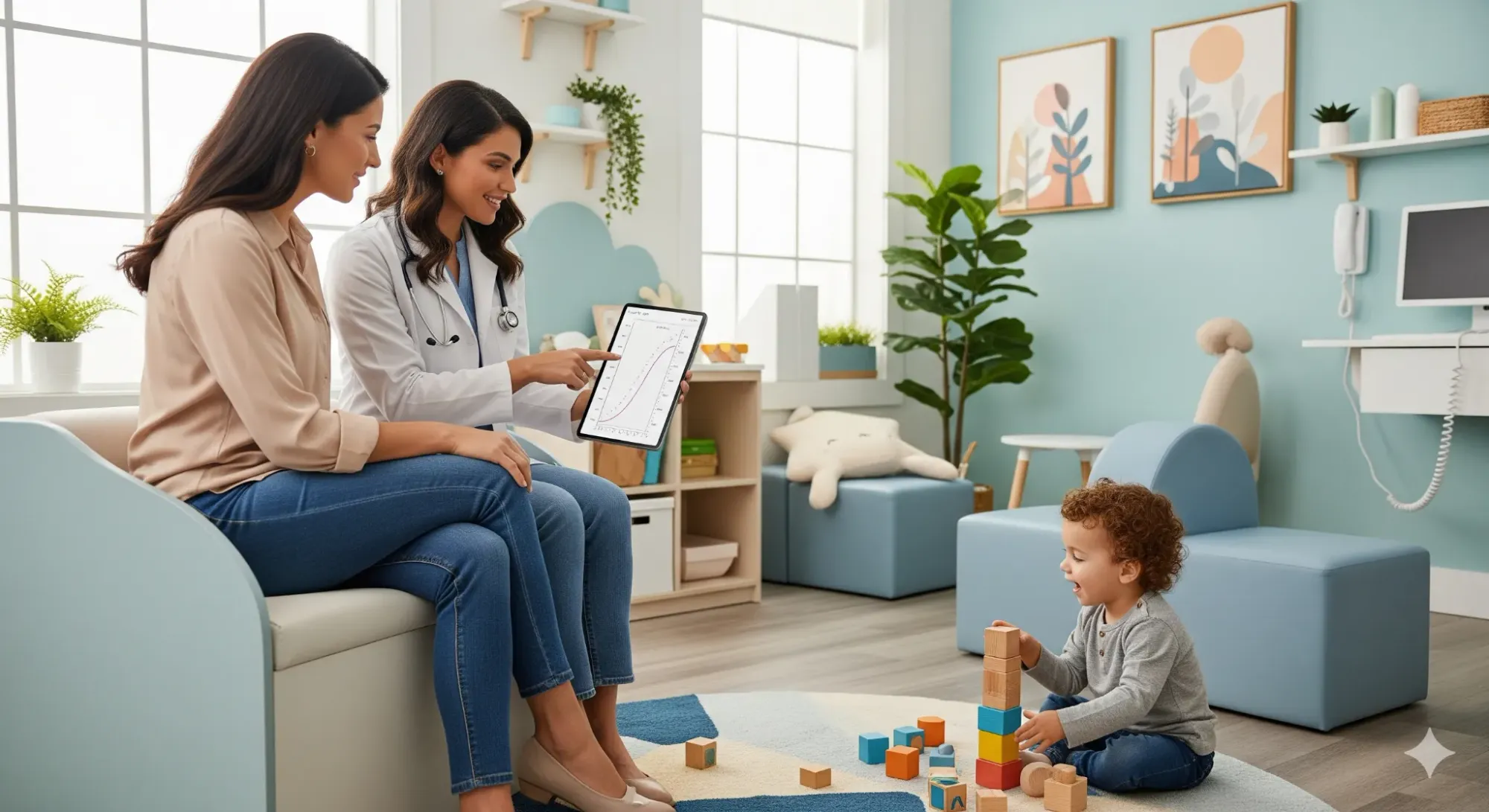
Pediatric care represents one of the greatest challenges within the healthcare system: caring for those who often cannot clearly express their pain, fears, or needs. For this reason, it is also one of the areas where humanizing care becomes most vital. The relationship between the healthcare professional, the child, and the family must be grounded in empathy, active listening, and trust, while also ensuring high clinical quality and strict control of health information.
Humanizing care, however, is not just about smiling or welcoming with kindness. In the pediatric context, true humanization also involves clinical safety, the efficient use of structured data, and the ability to communicate this information in a way that is accessible to parents and guardians. In this article, we will address how to make pediatric care more humanized and trustworthy.
Before we continue, we need to ask: Are you already familiar with Ninsaúde Clinic? Ninsaúde Clinic is a medical software with an agile and complete schedule, electronic medical records with legal validity, teleconsultation, financial control and much more. Schedule a demonstration or try Ninsaúde Clinic right now!

The Broader Concept of Humanization
Humanization in healthcare is often confused with empathy and sympathy, but it goes far beyond that. In pediatrics, especially, it manifests in three pillars:
- Effective communication with parents: translating medical jargon, presenting diagnoses clearly, and welcoming questions without judgment.
- A welcoming environment for the child: from the physical space to the language used by professionals.
- Data-based safety: using structured medical records, growth curves, vaccination schedules, and clinical history to ensure accurate and safe decisions.
A humanized consultation is one that values both the emotional and the technical aspects, without compromising either. This is where technology becomes a powerful ally.

The Electronic Medical Record as a Humanization Tool
In clinics that treat children, the electronic medical record should not be just a data repository but an active tool for communication and safety. Features such as a visual history of the patient’s progress, specialty-specific filters, and document storage (tests, photos, videos) allow professionals to make more informed and safer decisions.
For example, Ninsaúde Clinic offers personalized medical records with pediatric protocols, enabling detailed documentation of the child’s clinical evolution. With structured fields, professionals can accurately track data such as weight, height, head circumference, and symptoms, reducing the risk of error and enabling early interventions.
Integration among professionals is also a differentiator. In multidisciplinary clinics, communication between pediatricians, speech therapists, psychologists, and nutritionists can occur directly within the shared record, avoiding duplication, preventing communication failures, and improving therapeutic effectiveness.
Visual Data: Bringing Parents and Professionals Closer
One of the biggest challenges in pediatrics is engaging parents in care effectively, especially when it involves technical information. This is where turning data into visual graphics plays a fundamental role.
The growth chart is the most classic example: by graphically showing whether the child is within the expected standards set by the WHO, the professional reduces parental anxiety and builds a bridge of trust. When these data are integrated into the electronic medical record, follow-up becomes faster and more accurate.
In addition, features such as uploading tests with visual annotations or using images to explain medical conditions facilitate understanding. A simple annotated X-ray can help parents grasp why immobilization or surgery is needed.
Growth Curves: Turning Data into Dialogue with Parents
To make growth curves even more educational for parents, it is important to explain how they guide clinical decisions and reinforce care safety. By presenting the graph with percentiles (p3, p15, p50, p85, p97) and the child’s historical trajectory, the pediatrician translates technical concepts into a comprehensible story: “where your child was, where they are now, and what the trend is.”
Warning signs can be discussed objectively — for example: a drop across two percentile channels in a short period, weight gain plateau lasting more than three months in infants, BMI persistently above the 97th percentile (or below the 3rd), head circumference crossing percentiles, or significant mismatch between observed height and target familial height. Integrated into the medical record, this dialogue is documented, reduces anxiety, and anchors clinical decisions in data.
Best practices for discussing growth with families:
- Start with positives: highlight positive progress before addressing concerns, reinforcing adherence.
- Translate percentiles into meaning: explain that percentiles are not grades, but relative positions in the population.
- Compare with the child’s own trajectory: emphasize the patient’s growth line over time, not just an isolated measure.
- End with a clear plan: dietary/routine adjustments, necessary tests, and a reevaluation date.
With solutions like Ninsaúde Clinic, growth charts can be attached to the medical record with annotations, facilitating the documentation of clinical reasoning and secure sharing with parents — a concrete example of how well-presented data strengthens trust between parents and the care team.

Trust is Built with Accessibility and Documentation
Another key point is ensuring that all relevant information is accessible to parents and guardians, in a secure and structured way. Systems like Ninsaúde Clinic allow the sending of documents by email with electronic signatures, such as consent forms or treatment plans, promoting transparency and trust.
This accessibility also includes automatic appointment reminders, vaccination schedules, test results, and post-visit recommendations. A relationship based on continuity and information reduces the perceived distance between the clinic and the family.
The Importance of CRM in the Pediatric Experience
Managers aiming to invest in more humanized pediatric care cannot ignore the role of a medical CRM. This tool enables the segmentation of patients (by age, clinical condition, or type of follow-up) and the creation of adapted communication flows.
For example:
- Seasonal campaigns: reminders for flu shots or mandatory vaccine boosters.
- Automated follow-ups: messages after visits, asking about medication reactions or adherence to instructions.
- Continuous education: sending educational materials to parents about child nutrition, sleep, or motor development.
These actions show care, create value, and increase loyalty, while structuring the relationship in a professional and automated way.
Environment and Language: The Detail that Transforms
The care experience begins even before the consultation. The reception, room decoration, waiting time, and how the child is called all influence the perception of care.
Clinics that use resources such as QR Code check-in, personalized reception calls, and waiting room screens with children’s content create a lighter and more welcoming atmosphere. These tools are available in systems like Ninsaúde Clinic, which integrates everything from scheduling to patient check-in.
During the consultation, the language used is equally important. Explaining procedures in a playful way, involving the child in the examination process, and respecting their limits strengthen the bond and reduce fear.
Data Security: An Invisible but Essential Pillar
Finally, it is essential to remember that humanization is also expressed in guaranteeing the privacy and security of information. Systems that comply with data protection laws (such as LGPD, HIPAA, or GDPR) and include encryption, audit logs, and access controls demonstrate respect for the confidentiality of children’s data.
This factor, often invisible to parents, is a key element of trust in the service provided. It is a way of saying: “we value your child’s safety in every aspect, including digital security.”

From Care to Connection: The Future of Pediatrics is Relational
Making pediatric care more humanized and trustworthy requires a shift in mindset: moving away from a consultation-only focus and recognizing the entire family journey within the clinic. Personalized medical records, visual data, medical CRM, professional integration, and secure technology are tools that enable this transformation.
By uniting technical efficiency with trust-based relationships, the pediatric clinic becomes not just a place for diagnosis, but a true center of care and connection. And in this scenario, technology does not replace the human element: it enhances it.
Liked the information? Then prepare for a continuous journey of knowledge by following our blog. Are you a health professional and not yet familiar with the benefits of Ninsaúde Clinic? Stay ahead, optimize your processes, and elevate excellence in patient care!

